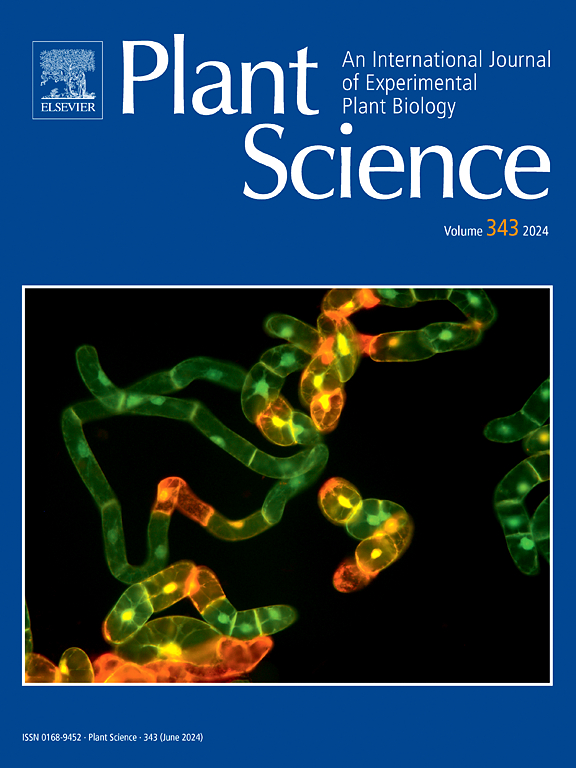Alternaria radicina xylanase is required for the occurrence of carrot black rot disease
IF 4.2
2区 生物学
Q2 BIOCHEMISTRY & MOLECULAR BIOLOGY
引用次数: 0
Abstract
Alternaria radicina, the causative agent of carrot black rot, causes significant damage to both the leaves and roots of carrots throughout the growing season. The pathogenic effectors are seldomly isolated and lack of functional studies. In this study, we performed genomic sequencing, assembly, and annotation of an A. radicina isolate. A. radicina genome is about 34.71 Mb, and contains 11,271 coding sequences. Based on the Pathogen Host Interactions (PHI) database, three xylanase genes containing the glycoside hydrolase 11 (GH11) domain are enriched. We further identify five xylanase genes (ArXyn1 ∼ ArXyn5) in A. radicina genome according to the amino acid sequence similarity, and investigate their functional roles in the infection process. The transcriptions of ArXyn1 and ArXyn3 are significantly induced in both A. radicina strain and infected leaf tissues during the infection. Transiently expressing ArXyn1 or ArXyn3 in Nicotiana benthamiana leaves triggers the cell death, which is dependent on the signal peptide localized at the N-terminal of each gene. Subcellular localization analysis reveals that both ArXyn1 and ArXyn3 are localized in the plasma membrane, cytosol, nucleus and extracellular spaces of N. benthamiana leaf cells. Deleting either ArXyn1 or ArXyn3 slightly reduces the fungal growth on the medium. The ArXyn1 or ArXyn3 deletion mutant cause less severe disease symptoms on carrot leaves and roots than wild type strain. Scanning electron microscopy reveals that both mutants cause reduced cell wall damages compared to wild type strain. Taken together, our results suggest that xylanases contribute to A. radicina virulence, and play important roles in the occurrence of carrot black rot disease.
胡萝卜黑腐病的发生需要根瘤菌木聚糖酶
胡萝卜黑腐病的病原——根瘤菌在整个生长季节对胡萝卜的叶和根都造成了严重的损害。致病效应物很少被分离出来,缺乏功能研究。在这项研究中,我们对一株根芽孢杆菌进行了基因组测序、组装和注释。根线虫基因组约34.71 Mb,包含11,271个编码序列。基于病原菌宿主相互作用(PHI)数据库,对含有糖苷水解酶11 (GH11)结构域的3个木聚糖酶基因进行了富集。根据氨基酸序列相似性,我们进一步鉴定出5个木聚糖酶基因(ArXyn1 ~ ArXyn5),并研究了它们在侵染过程中的功能作用。在侵染过程中,ArXyn1和ArXyn3的转录在根霉菌株和侵染叶片组织中均被显著诱导。在烟叶中短暂表达ArXyn1或ArXyn3会触发细胞死亡,这取决于每个基因n端定位的信号肽。亚细胞定位分析表明,ArXyn1和ArXyn3均定位于benthamiana叶片细胞的质膜、胞浆、细胞核和胞外间隙。删除ArXyn1或ArXyn3中的任何一个都会略微降低培养基上的真菌生长。与野生型相比,ArXyn1或ArXyn3缺失突变体对胡萝卜叶片和根部的疾病症状较轻。扫描电镜显示,与野生型菌株相比,这两种突变体对细胞壁的损害都减少了。综上所述,我们的研究结果表明木聚糖酶参与了根霉的毒力,并在胡萝卜黑腐病的发生中发挥了重要作用。
本文章由计算机程序翻译,如有差异,请以英文原文为准。
求助全文
约1分钟内获得全文
求助全文
来源期刊

Plant Science
生物-生化与分子生物学
CiteScore
9.10
自引率
1.90%
发文量
322
审稿时长
33 days
期刊介绍:
Plant Science will publish in the minimum of time, research manuscripts as well as commissioned reviews and commentaries recommended by its referees in all areas of experimental plant biology with emphasis in the broad areas of genomics, proteomics, biochemistry (including enzymology), physiology, cell biology, development, genetics, functional plant breeding, systems biology and the interaction of plants with the environment.
Manuscripts for full consideration should be written concisely and essentially as a final report. The main criterion for publication is that the manuscript must contain original and significant insights that lead to a better understanding of fundamental plant biology. Papers centering on plant cell culture should be of interest to a wide audience and methods employed result in a substantial improvement over existing established techniques and approaches. Methods papers are welcome only when the technique(s) described is novel or provides a major advancement of established protocols.
 求助内容:
求助内容: 应助结果提醒方式:
应助结果提醒方式:


